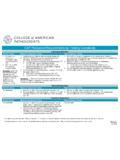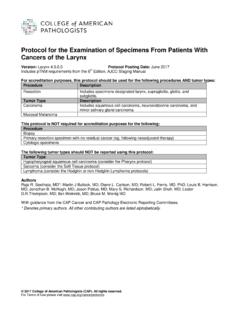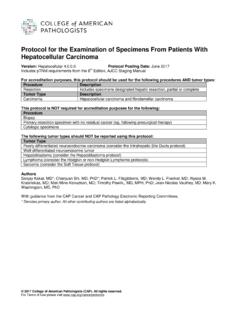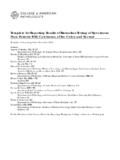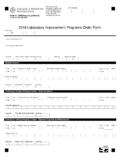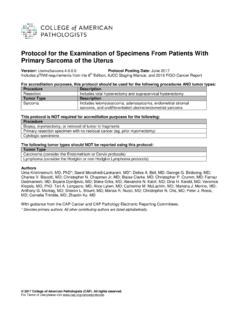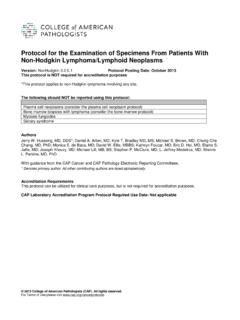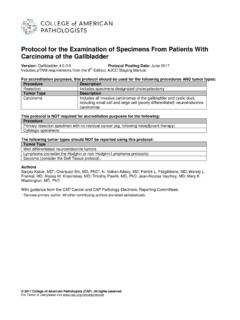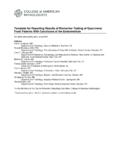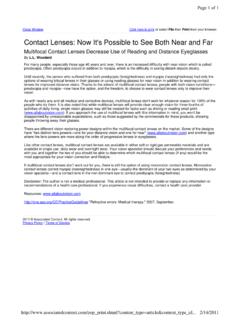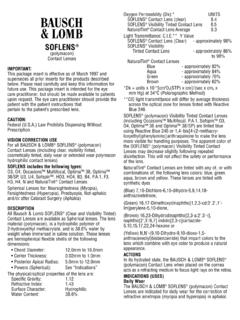Transcription of CAP Cancer Protocol Soft Tissue
1 Protocol for the Examination of Specimens From Patients With soft Tissue Tumors Version: softtissue Protocol Posting Date: June 2017 Includes pTNM requirements from the 8th Edition, AJCC Staging Manual For accreditation purposes, this Protocol should be used for the following procedures and tumor types: Procedure Description Resection Includes specimens designated intralesional resection, marginal resection, wide resection, and radical resection Tumor Type Description soft Tissue sarcomas Includes soft Tissue tumors of intermediate (locally aggressive and rarely metastasizing) potential and malignant soft Tissue tumors. This Protocol is NOT required for accreditation purposes for the following: Procedure Biopsy (includes core needle biopsy, incisional biopsy, or excisional biopsy) Primary resection specimen with no residual or viable Cancer (eg, following neoadjuvant therapy) Cytologic specimens Tumor type soft Tissue tumors that may recur locally but have either no or an extremely low risk of metastasis (see Note K) The following tumor types should NOT be reported using this Protocol : Tumor Type Carcinosarcoma (consider the appropriate site-specific carcinoma Protocol ) Lymphoma (consider the Hodgkin or non-Hodgkin Lymphoma protocols) Pediatric Ewing sarcoma (consider the Ewing Sarcoma Protocol ) Pediatric rhabdomyosarcoma (consider the Rhabdomyosarcoma Protocol ) Kaposi sarcoma Gastrointestinal stromal tumor (consider the Gastrointestinal Stromal Tumor Protocol ) Uterine sarcoma (consider the Uterine Sarcoma Protocol ) Authors Javier A.
2 Laurini, MD*; Kumarasen Cooper, MBChB, DPhil; Christopher Fletcher, MD; Andrew Lawrence Folpe, MD; Francis H. Gannon, MD; Jennifer Leigh Hunt, MD; Thomas Krausz, MD; Alexander Lazar, MD, PhD; Anthony G. Montag, MD; Jordan Olson, MD; Terrance D. Peabody, MD; Raphael E. Pollock, MD, PhD; John D. Reith, MD; Brian P. Rubin, MD; Andrew E. Rosenberg, MD, PhD; Sharon W. Weiss, MD With guidance from the CAP Cancer and CAP Pathology Electronic Reporting Committees. * Denotes primary author. All other contributing authors are listed alphabetically. 2017 College of American Pathologists (CAP). All rights reserved. For Terms of Use please visit Other soft Tissue softtissue Accreditation Requirements This Protocol can be utilized for a variety of procedures and tumor types for clinical care purposes. For accreditation purposes, only the definitive primary Cancer resection specimen is required to have the core and conditional data elements reported in a synoptic format. Core data elements are required in reports to adequately describe appropriate malignancies.
3 For accreditation purposes, essential data elements must be reported in all instances, even if the response is not applicable or cannot be determined. Conditional data elements are only required to be reported if applicable as delineated in the Protocol . Optional data elements, are identified with + and although not required for CAP accreditation purposes, may be considered for reporting as determined by local practice standards The use of this Protocol is not required for recurrent tumors or for metastatic tumors that are resected at a different time than the primary tumor. Use of this Protocol is also not required for pathology reviews performed at a second institution ( secondary consultation, second opinion, or review of outside case at second institution). Synoptic Reporting All core and conditionally required data elements outlined on the surgical case summary from this Cancer Protocol must be displayed in synoptic report format. Synoptic format is defined as: Data element: followed by its answer (response), outline format without the paired "Data element: Response" format is NOT considered synoptic.
4 The data element must be represented in the report as it is listed in the case summary. The response for any data element may be modified from those listed in the case summary, including Cannot be determined if appropriate. Each diagnostic parameter pair (Data element: Response) is listed on a separate line or in a tabular format to achieve visual separation. The following exceptions are allowed to be listed on one line: o Anatomic site or specimen, laterality, and procedure o Pathologic Stage Classification (pTNM) elements o Negative margins, as long as all negative margins are specifically enumerated where applicable The synoptic portion of the report can appear in the diagnosis section of the pathology report, at the end of the report or in a separate section, but all Data element: Responses must be listed together in one location Organizations and pathologists may choose to list the required elements in any order, use additional methods in order to enhance or achieve visual separation, or add optional items within the synoptic report.
5 The report may have required elements in a summary format elsewhere in the report IN ADDITION TO but not as replacement for the synoptic report all required elements must be in the synoptic portion of the report in the format defined above. CAP Laboratory Accreditation Program Protocol Required Use Date: March 2018* * Beginning January 1, 2018, the 8th edition AJCC Staging Manual should be used for reporting pTNM CAP soft Tissue Summary of Changes Biopsy The following data elements were modified: Tumor Site Lymphovascular Invasion The following data elements were deleted: Tumor Size Macroscopic Extent of the Tumor Resection The following data elements were modified: Tumor Site Tumor Size Margins Lymphovascular Invasion Pathologic Staging (pTNM) (8th Edition) The following data elements were deleted: Macroscopic Extent of the Tumor 2 CAP Approved Other soft Tissue softtissue Surgical Pathology Cancer Case Summary Protocol posting date: June 2017 soft Tissue : Biopsy Note: This case summary is recommended for reporting biopsy specimens, but is not required for accreditation purposes.
6 Select a single response unless otherwise indicated. Procedure (Note A, Note B) ___ Core needle biopsy ___ Incisional biopsy ___ Excisional biopsy ___ Other (specify): _____ ___ Not specified Tumor Site (Note C) ___ Head and neck (specify site, if known): _____ ___ Trunk and extremities (specify site, if known): _____ ___ Abdominal visceral organ(s) (specify site, if known): _____ ___ Thoracic visceral organ(s) (specify site, if known): _____ ___ Retroperitoneum (specify site, if known): _____ ___ Orbit (specify site, if known): _____ ___ Not specified Histologic Type (World Health Organization [WHO] classification of soft Tissue tumors) (Note D) Specify: _____ ___ Cannot be determined Mitotic Rate (Note E) Specify: ___ /10 high-power fields (HPF) (1 HPF x 400 = mm2; X40 objective; most proliferative area) Necrosis (Note E) ___ Not identified ___ Present Extent: ___% ___ Cannot be determined Histologic Grade (French Federation of Cancer Centers Sarcoma Group [FNCLCC]) (Note E) ___ Grade 1 ___ Grade 2 ___ Grade 3 ___ Ungraded sarcoma ___ Cannot be assessed + Data elements preceded by this symbol are not required for accreditation purposes.
7 These optional elements may be clinically important but are not yet validated or regularly used in patient management. 3 CAP Approved Other soft Tissue softtissue Margins (for excisional biopsy only) (Note F) ___ Cannot be assessed ___ Uninvolved by sarcoma Distance of sarcoma from closest margin (centimeters): ___ cm Specify margin: _____ Specify other close (< cm) margin(s): _____ ___ Involved by sarcoma Specify margin(s): _____ + Lymphovascular Invasion (Note G) + ___ Not identified + ___ Present + ___ Cannot be determined + Additional Pathologic Findings + Specify: _____ Ancillary Studies (required only if applicable) Immunohistochemistry (specify): _____ ___ Not performed Cytogenetics (specify): _____ ___ Not performed Molecular Pathology (specify): _____ ___ Not performed + Prebiopsy Treatment (select all that apply) + ___ No known prebiopsy therapy + ___ Chemotherapy performed + ___ Radiation therapy performed + ___ Therapy performed, type not specified + ___ Not specified +Treatment Effect (Note H) +__ No known prebiopsy therapy +__ Not identified +__ Present + Specify percentage of viable tumor: ____% +__ Cannot be determined + Comment(s) + Data elements preceded by this symbol are not required for accreditation purposes.
8 These optional elements may be clinically important but are not yet validated or regularly used in patient management. 4 CAP Approved Other soft Tissue softtissue Surgical Pathology Cancer Case Summary Protocol posting date: June 2017 soft Tissue : Resection Select a single response unless otherwise indicated. Procedure (Note A, Note B) ___ Intralesional resection ___ Marginal resection ___ Wide resection ___ Radical resection ___ Other (specify): _____ ___ Not specified Tumor Site (Note C) ___ Head and neck (specify site, if known): _____ ___ Trunk and extremities (specify site, if known): _____ ___ Abdominal visceral organs (specify site, if known): _____ ___ Thoracic visceral organs (specify site, if known): _____ ___ Retroperitoneum (specify, if known): _____ ___ Orbit (specify site, if known): _____ ___ Not specified Tumor Size (Note I) Greatest dimension (centimeters): ___ cm + Additional dimensions (centimeters): ___ x ___ cm ___ Cannot be determined (explain): _____ Histologic Type (World Health Organization [WHO] classification of soft Tissue tumors) (Note D, Note J) Specify: _____ ___ Cannot be determined Mitotic Rate (Note E) Specify: ___ /10 high-power fields (HPF) (1 HPF x 400 = mm2; X40 objective.)
9 Most proliferative area) Necrosis (macroscopic or microscopic) (Note E) ___ Not identified ___ Present Extent: ____% Histologic Grade (French Federation of Cancer Centers Sarcoma Group [FNCLCC]) (Note E) ___ Grade 1 ___ Grade 2 ___ Grade 3 ___ Ungraded sarcoma ___ Cannot be assessed + Data elements preceded by this symbol are not required for accreditation purposes. These optional elements may be clinically important but are not yet validated or regularly used in patient management. 5 CAP Approved Other soft Tissue softtissue Margins (Note F) ___ Cannot be assessed ___ Uninvolved by sarcoma Distance of sarcoma from closest margin (centimeters): ___ cm Specify closest margin: _____ Specify other close (less than centimeters) margin(s) (if applicable): _____ ___ Involved by sarcoma Specify margin(s): _____ + Lymphovascular Invasion (Note G) + ___ Not identified + ___ Present + ___ Cannot be determined Regional Lymph Nodes (Notes K and L) ___ No lymph nodes submitted or found Lymph Node Examination (required only if lymph nodes present in specimen) Number of Lymph Nodes Involved: _____ ___ Number cannot be determined (explain): _____ Number of Lymph Nodes Examined: _____ ___ Number cannot be determined (explain): _____ Pathologic Stage Classification (pTNM, AJCC 8th Edition) (Note K) Note: Reporting of pT, pN, and (when applicable) pM categories is based on information available to the pathologist at the time the report is issued.
10 Only the applicable T, N, or M category is required for reporting; their definitions need not be included in the report. The categories (with modifiers when applicable) can be listed on 1 line or more than 1 line. ___ Histologic type not appropriate for staging# # Note: Regardless of the anatomic site, certain specific types of locally aggressive soft Tissue neoplasms, which may recur locally but have either no risk of metastatic disease or an extremely low risk of metastasis, are excluded from the AJCC soft Tissue sarcoma staging system. See Note K for a comprehensive list. TNM Descriptors (required only if applicable) (select all that apply) ___ m (multiple) ___ r (recurrent) ___ y (posttreatment) Primary Tumor (pT) Head and Neck ___ pTX: Primary tumor cannot be assessed ___ pT1: Tumor 2 cm ___ pT2: Tumor >2 to 4 cm ___ pT3: Tumor >4 cm ___ pT4: Tumor with invasion of adjoining structures ___ pT4a: Tumor with orbital invasion, skull base/dural invasion, invasion of central compartment viscera, involvement of facial skeleton, or invasion of pterygoid muscles ___ pT4b: Tumor with brain parenchymal invasion, carotid artery encasement, prevertebral muscle invasion, or central nervous system involvement via perineural spread + Data elements preceded by this symbol are not required for accreditation purposes.
